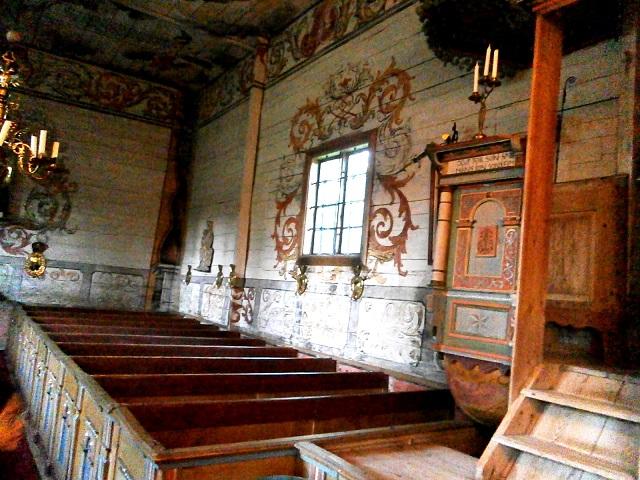Singing with Morsan in Sweden
Vem kan segla förutan vind?
Vem kan ro utan åror?
(Who can sail without the wind?
Who can row without oars?...)
—Traditional Swedish Song
Mimi, sister of poet-friend John, and her Swedish husband Jonas and their daughter Juliet were excited to show us around when we visited them in Sweden. They lived in Lenhovda, near Växjö, in Småland, in the southern part of the country, near Malmo.
On the first day we went around Lenhovda and I noted the dense forest surrounding the area. They took us to the lake, a large body of water, near their home, and the serenity of the place was calming. The surrounding view too, was breathtaking in its pristine beauty, the air so clean and fresh.

We went to say hello to Jonas’ 76-year-old mother, who lived in Marhult, a village about 15 minutes away by car from Lenhovda. Morsan (pronounced moo-shan), or Mom, lived alone with about ten cats in a beautiful house surrounded by rolling hills, tall trees, and horses. John, who had regaled me of his visit the year before, described Morsan’s “cottage” (actually a big house with three bedrooms) in his poems and essays, as magical and enchanting, and we were eager to visit her. We passed by winding country paths, with bales of hay all neatly stacked by the roadside.
Morsan was waiting in her home, an airy, light-filled, spacious place where multi-colored flowers bloomed—inside and out. It was late spring when we visited, and so many blue cornflowers, pink carnations, yellow and white daisies, were placed in jars all around the house, some hanging from the window alcoves. The house came alive with the beautiful colors as if painted by an artist. Morsan spoke no English, but we were able to communicate through Jonas, and she was very happy to receive our pasalubongs. Two of her large cats, Pele and Maria were dozing in the chairs, content and happy. We were exclaiming too, over the coziness of the many cushioned sofas around the house, and saw the stationary bike that she used after her bout with bone cancer and hip operations.
Morsan called us from her kitchen, and we saw freshly cooked, heart-shaped waffles on her colorful table, with homemade strawberry jam and whipped cream. We smelled strong coffee too, wafting from her stove, and after pouring us all big cups of the brew she sat down and asked about our trip. She was smiling all throughout, and looked kind. But she had a commanding presence, and a no-nonsense air about her.
Have you shown them the church, she asked. Jonas said he was taking us there after our coffee, and Morsan said to make sure we brought the keys. From John too, I have heard about the Granhult Church, one of the few surviving medieval timber churches in Sweden. Constructed during the Middle Ages, it had withstood world wars and attempts to destroy it because of the dwindling population, but the locals, mostly farmers, held on, and petitioned the bishop and even the king so they could keep their church. Morsan and a group of volunteers regularly baked cakes and pastries and organized bake sales as a fund-raising activity.
Granhult
We drove for about 10 minutes to Granhult, and from afar we saw a timber structure with a cross at the apex of the roof. Coming down from the car we discovered a churchyard where tombstones, old and new, lined the ground. Jonas’ father was buried there. There was a tall, old bell-tower of the trestle type (it stood on a tripod of three timber legs) erected in 1703.

The church itself was unassuming, made of timber wood and its style has never changed since its construction in 1220, except for an additional vestry and the porch with an enlargement of a window opening. As we went in, I could smell old wood, and wax. Our eyes adjusted to the semi-darkness, but we could see the rich intricate colored paintings on the walls. Jonas switched on the lights, and we exclaimed over the artworks before us. We entered through the door at the west side, and saw the enthroned 15th century image of St. Olaf, the martyred Christian king of Sweden, at the center of the wall. He was stepping on a dragon, with a human head, said to belong to his half-brother Harald, who was a heathen and his rival to the crown.
The wooden ceiling had an 18th century painting from the Revelation called the “Throne of God in Heaven,” encircled in a colorful manner with angels and humans kneeling in adoration.
The main altar showed a crucified Christ, painted by Torbern Röding of Växjö in 1699, surrounded by the events of Christ’s death. Huge trompe l’oeil curtain paintings with colorful roundels and figure scenes made the altar look alive and three dimensional. The pews too, were installed during the 17th century, almost at the same time as the beautiful pulpit.
A Swedish song
A few days later we visited Morsan again, and this time we felt like old friends. She was in a more expansive mood, and served us homemade cookies and freshly brewed coffee. What about the song you learned for this trip, Jonas asked. Would you want to sing it for Morsan? For the past six months I had been trying to sing a Swedish song whose melody and cadence had entranced me, so I tried learning it by heart, wanting to delight my hosts. Upon the encouragement of Jonas I summoned up courage to sing the song to her, as a way of thanking her for her hospitality: “Vem kan segla för utan vind?...” When I was singing the third line, I heard her sing it with me, a quiet lilt to her soft voice. I saw Jonas smile broadly, as we started on the second stanza, our voices becoming one, a bit louder now, resonating in the cottage lit by the late afternoon sun. I hugged her warmly after that, and there was no need for words.

When I look back at our trip to Sweden, the first thing that comes to mind was that afternoon, singing with Morsan. She did not want her photograph taken, so we did not have any photos of her. But that did not matter. Our trip to Marhult where she lived, and to Granhult where she worshipped, was always in our hearts. There was no need for photographs.
…Vem kan skiljas från vännen sin
Utan att fälla tårar?
(Who can say goodbye to a friend
Without shedding tears?)
—KG, GMA News



